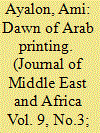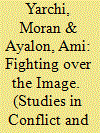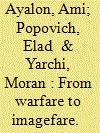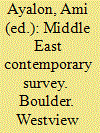|
|
|
Sort Order |
|
|
|
Items / Page
|
|
|
|
|
|
|
| Srl | Item |
| 1 |
ID:
163250


|
|
|
|
|
| Summary/Abstract |
The adoption of printing in the Ottoman Arab provinces in the nineteenth century portended a cultural transformation with profound implications, known as the nahda. Focusing on the Syrian town of Tripoli (Tarabulus al-Sham) as a case study, the article examines the historic cultural change from a peripheral vantage point. It looks at the impact of Arab printing and publishing, which evolved primarily in Cairo, Alexandria, and Beirut, on a community on the fringe of cultural change and examines its cultural interrelationship with these centers. Its findings show that, more than acting as mere consumers of print, Tripoli residents in substantial numbers took an active part in the discourse on social and cultural dilemmas which printing facilitated across the region, before adopting similar novelties in their own town toward the end of the century. The probe casts light on the manifold process by which printing, its products, and its diffusion mechanisms spread throughout the region. As printing was a key channel for circulating news and views, the study also affords a credible notion of the role that communities away from the production epicenters played in the nahda.
|
|
|
|
|
|
|
|
|
|
|
|
|
|
|
|
| 2 |
ID:
189338


|
|
|
|
|
| Summary/Abstract |
The current paper analyzes the recent wave of violence in the Israeli–Palestinian conflict, and especially the occurrences on the Gazan border since March 2018, from a less covered point of view – the battle over the image and narrative. The Palestinians’ main tools of resistance during this wave of violence have been civilian protests near the fence and the launching of explosive kites and balloons across the border – causing massive damage to Israeli agriculture. We argue that the Palestinians had waged a sophisticated Image War on the border of Gaza, and while they are performing, the world is watching.
|
|
|
|
|
|
|
|
|
|
|
|
|
|
|
|
| 3 |
ID:
144921


|
|
|
|
|
| Summary/Abstract |
Conflicts in the 21st century differ from past conflicts based on two central factors: the level of asymmetry and disparity between the actors taking part in the conflict and the amount of foreign media coverage that a conflict receives. This article aims to develop a new theoretical perspective on the implications of these two factors on how the involved states manage a conflict. Most actors in current conflicts have vast levels of disparity and receive extensive media coverage; events in those conflicts are referred to as occurrences in the “information space” because a conflict's borders are anywhere people can receive information about it. “Imagefare”—the use of images as a guiding principle or a substitute for traditional military means to achieve political objectives—is argued to be the main tool for better facing adversaries in the information space.
|
|
|
|
|
|
|
|
|
|
|
|
|
|
|
|
| 4 |
ID:
068066


|
|
|
|
|
| Publication |
London, Routledge, 2006.
|
| Description |
viii, 258p.Hbk
|
| Series |
Routledge studies in Middle Eastern history
|
| Standard Number |
041537278X
|
|
|
|
|
|
|
|
|
|
|
|
Copies: C:1/I:0,R:0,Q:0
Circulation
| Accession# | Call# | Current Location | Status | Policy | Location |
| 050917 | 909.0976701/WAS 050917 | Main | On Shelf | General | |
|
|
|
|
| 5 |
ID:
002813


|
|
|
|
|
| Publication |
Boulder, Westview Press, 1992.
|
| Description |
xxxvi,758p.hbk
|
| Contents |
Vol. XIV
|
| Standard Number |
0813314496
|
|
|
|
|
|
|
|
|
|
|
|
Copies: C:1/I:0,R:1,Q:0
Circulation
| Accession# | Call# | Current Location | Status | Policy | Location |
| 034319 | 028.70956/AYA 034319 | Main | On Shelf | Reference books | |
|
|
|
|
| 6 |
ID:
084680


|
|
|
|
|
| Publication |
2008.
|
| Summary/Abstract |
Khalil Sarkis (1842-1915) was an eminent figure in late Ottoman Beirut and an important contributor to the nah a, the Arab literary-cultural "awakening" that began in the latter part of the 19th century. Less known to Western scholarship than Butrus al-Bustani, Faris al-Shidyaq, or Jurji Zaydan, he is not usually regarded as a pillar of that awakening. He may not have been, but he certainly was an indispensable brick in its edifice. Born in 1842, when the most exciting changes were still in the future, Sarkis spent all his life in the service of his country's cultural betterment. He is mostly remembered for his newspaper, Lisan al-Hal, which was launched in 1877 and for many decades was one of the most credible Arabic organs. More than a journalist, however, Sarkis was a pioneering printer, a prolific publisher, and the author of nine books. In the last quarter of the 19th century he built one of Beirut's largest printing businesses, which turned out several journals, hundreds of books, and numerous publications. In the 19th-century Middle East, being a printer often meant being a publisher; Khalil Sarkis was both on a grand scale.
|
|
|
|
|
|
|
|
|
|
|
|
|
|
|
|
|
|
|
|
|